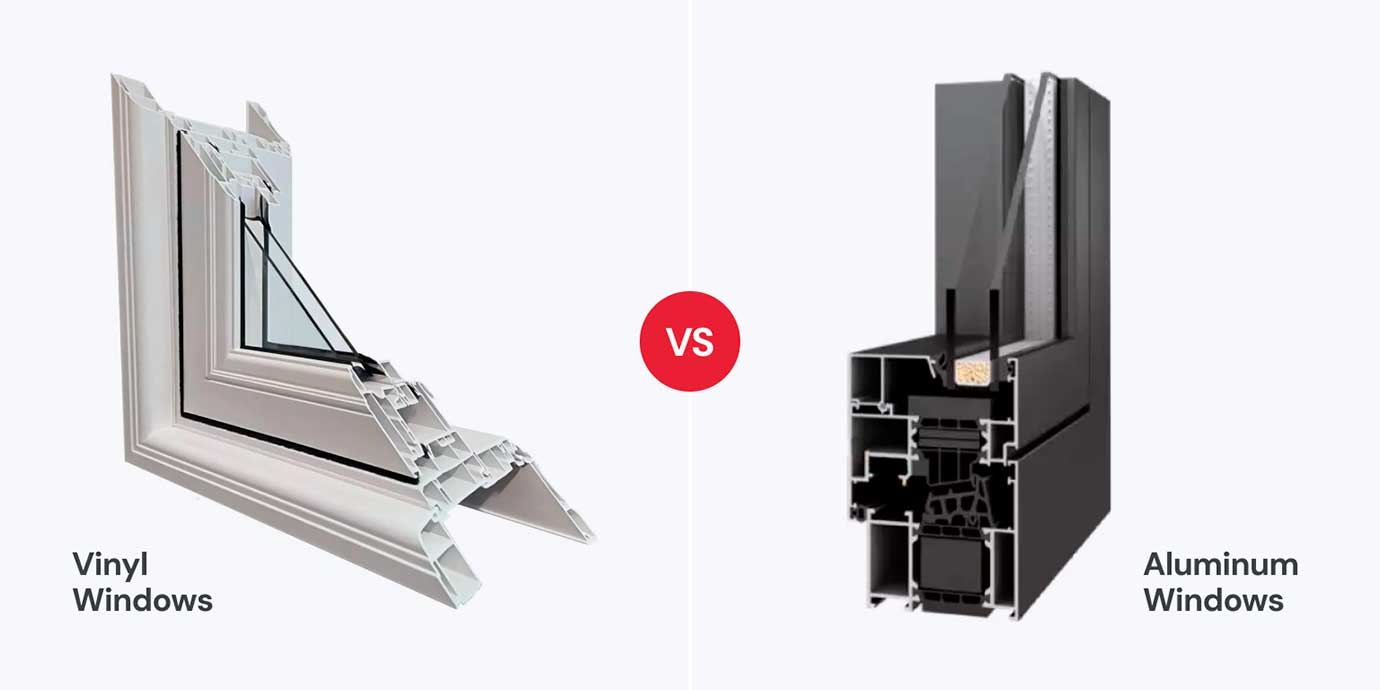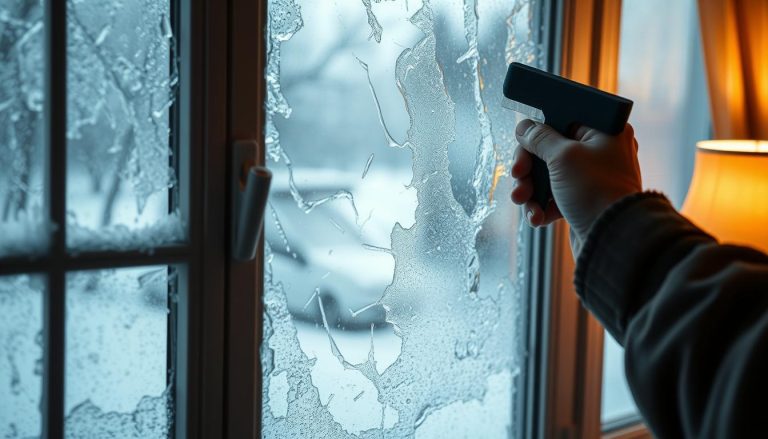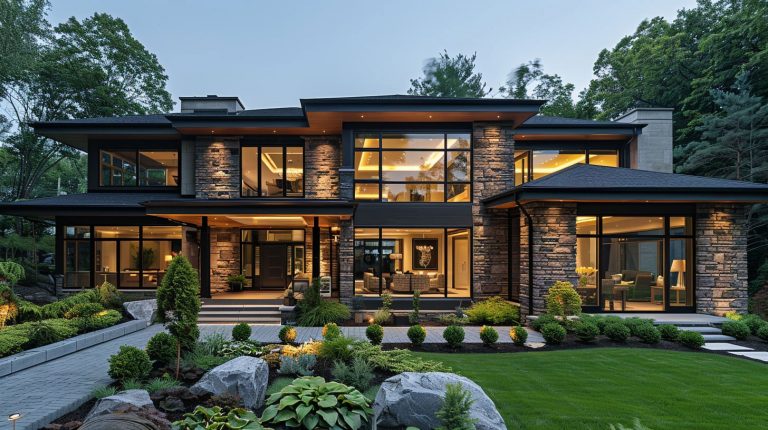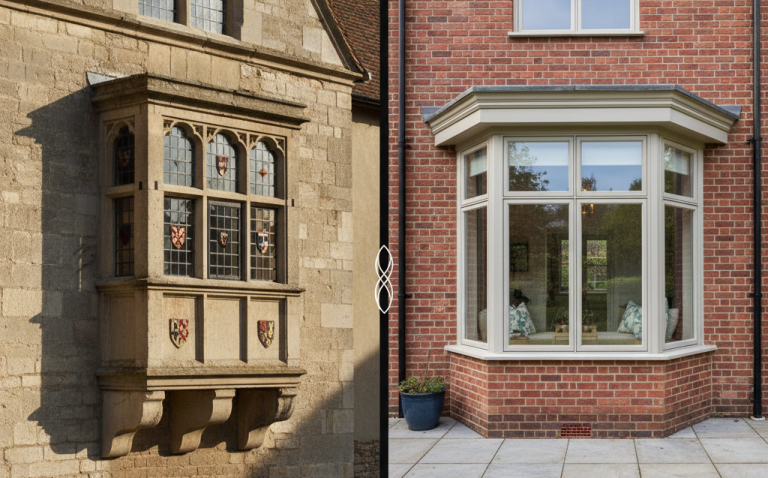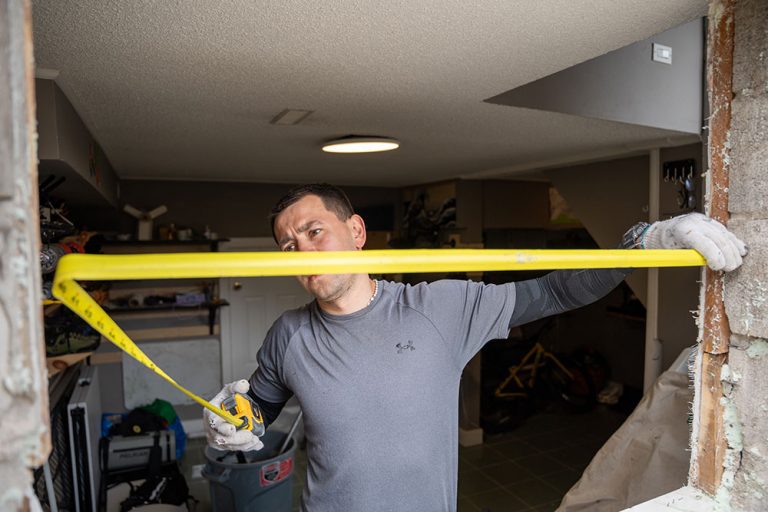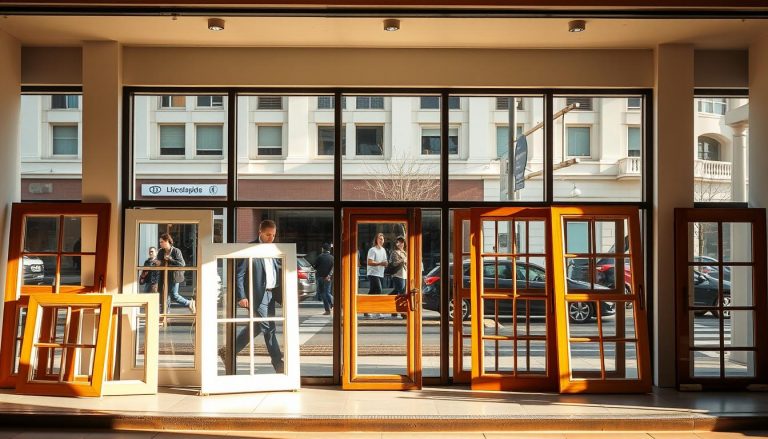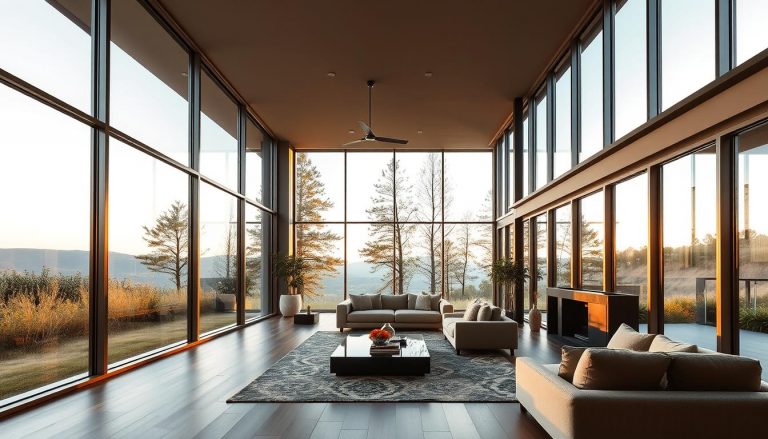Did You Know? Our Canadian Climate Is Costing You Money Through Your Windows.
The average Canadian home loses up to 30% of its heating and cooling energy through windows. With our extreme temperature fluctuations from -30°C in winter to +30°C in summer, choosing between vinyl and aluminum windows isn’t just about aesthetics—it’s about protecting your comfort and your wallet. Most homeowners don’t realize that the wrong window material can increase energy bills by 15-25% annually, which translates to thousands of dollars over the lifetime of your windows.
As a sales consultant at Total Home Windows and Doors with over a decade of experience helping Canadian homeowners make informed decisions, I’ve seen firsthand how the right choice between vinyl and aluminum windows can transform a home’s energy efficiency, maintenance requirements, and overall comfort.
Window Replacement Near Me
Side-by-side Comparison
Vinyl Windows
The Canadian Homeowner's Favorite

Vinyl windows, made from polyvinyl chloride (PVC), have become exceptionally popular among Canadian homeowners, accounting for over 70% of residential window installations. These windows offer excellent insulation properties through their multi-pane designs and air-tight seals.
Find related products
Aluminum Windows
Sleek, Strong, and Sophisticated
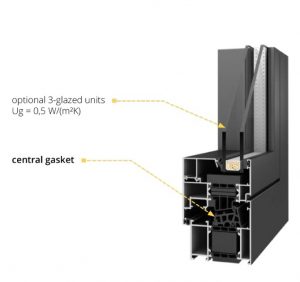
Aluminum windows offer unmatched structural integrity with a distinctly contemporary look that architects and designers often prefer for modern homes. Typically finished with durable enamel paint or powder coating, these windows provide a sleek, minimalist aesthetic while allowing for larger glass areas and thinner frames.
Pros of Vinyl Windows
Pros of Aluminum Windows
What is the downside of vinyl windows?
What is the disadvantage of aluminum windows?
"When homeowners prioritize energy efficiency and value, vinyl windows consistently deliver the best return on investment," says Eugene Siukayev, Project Manager. "For most Canadian homes, vinyl offers the perfect balance of performance and affordability."
"The resurgence of aluminum windows in high-end Canadian homes is tied directly to the trend toward contemporary architectural styles with expansive glazing," explains Vitaly Shapiro, Vice President of Sales. "When clients want that dramatic wall of glass or floor-to-ceiling window experience, aluminum frames provide the necessary structural support while maintaining clean lines."
Thermal Break Aluminum Windows vs. Vinyl
When comparing energy performance, standard aluminum windows typically underperform compared to vinyl. However, thermal break aluminum windows—which incorporate a non-conductive durable material between interior and exterior aluminum sections—significantly narrow this gap.
"Thermal break technology has been a game-changer for aluminum windows in the Canadian market," explains Daniel Klein, Project Manager. "By reducing heat transfer through the frame, these advanced designs can achieve performance metrics much closer to vinyl, while still offering the aesthetic advantages of aluminum."
Even with thermal breaks, however, most energy efficiency testing shows that vinyl windows still maintain a slight edge in reducing energy consumption in harsh Canadian winters. Many homeowners in particularly cold regions like Northern Ontario or the Prairies choose vinyl for maximum thermal performance.
Vinyl Windows Cost vs. Aluminum Windows Cost
Cost remains one of the most significant factors in window selection. The average costs for standard-sized windows are:
| Window Type | Average Cost Per Window (Installed) | ROI at Home Sale |
| Vinyl Windows | $900 - $1,400 | 72.5% |
| Standard Aluminum | $1,100 - $1,800 | 69.3% |
| Thermal Break Aluminum | $1,300 - $2,200 | 70.8% |
These figures represent national averages for replacement windows, with considerable regional variation. Urban centers like Toronto, Vancouver, and Montreal typically see costs at the higher end of these ranges.
"For a typical three-bedroom home requiring 10-12 new windows, the cost difference between vinyl and premium aluminum can easily reach $5,000-$8,000," says Anna Klein. "That's why many homeowners carefully weigh the long-term energy savings against the upfront investment when deciding"
Comprehensive Comparison Table
| Feature | Vinyl Windows | Aluminum Windows |
| Frame Material | Polyvinyl chloride (PVC) | Aluminum alloy |
| Average Lifespan | 20-30 years | 30-40+ years |
| Energy Efficiency | Excellent (U-value 0.25-0.35) | Fair to Good (U-value 0.35-0.55) |
| Maintenance Requirements | Minimal (occasional cleaning) | Moderate (cleaning + special aluminum cleaner for coastal areas) |
| Price Range | $$ | $$$ |
| Strength | Good | Excellent |
| Frame Width | Wider | Narrower |
| Color Options | Limited but improving | Extensive |
| Customization | Moderate | Extensive |
| Best For | Energy-efficient, budget-conscious homeowners | Modern design, strength, coastal areas |
| Environmental Impact | Moderate | Better (highly recyclable) |
Similarities Between Vinyl and Aluminum Windows
Despite their differences, both vinyl and aluminum windows share several essential features that make them popular choices among Canadian homeowners:
- Durability: Both materials are significantly more durable than wood, with minimal warping, rotting, or pest concerns.
- Variety of Styles: Both vinyl and aluminum windows are available in all significant window styles, including casement windows, double-hung windows, slider windows, awning windows, and specialty shapes.
- Low Maintenance: Compared to wood, vinyl and aluminum require considerably less upkeep and don’t need regular repainting.
- Multi-Pane Options: Both window types can accommodate double or triple glazing, low-E coatings, and gas fills for improved performance.
- Professional Installation: For optimal performance, qualified professionals should install both window types to ensure proper sealing and operation.
"What surprises many of our clients is how both vinyl and aluminum windows have evolved to address their traditional weaknesses," notes Vitaly Shapiro. "Today's vinyl offers better strength and design options than ever, while aluminum's energy performance has improved dramatically with thermal break technology."
Key Differences Table
| Factor | Vinyl Windows | Aluminum Windows |
| Frame Thickness | Thicker frames (2-3") | Slimmer frames (1-2") |
| Heat Conductivity | Low (good insulator) | High (poor insulator without thermal breaks) |
| Weight | Lighter | Heavier |
| Expansion/Contraction | More movement with temperature changes | Minimal expansion/contraction |
| Cold Weather Performance | Excellent | Fair to Good (with thermal breaks) |
| Coastal Performance | Good | Excellent (with proper finishing) |
| Modern Aesthetic | Good | Excellent |
| Frame Colors | Limited (though improving) | Extensive options |
| DIY Friendly | More accessible | Less DIY friendly |
| Initial Cost | Lower | Higher |
| Long-term Value | Better for energy savings | Better for design statement |
Which Is Better: Vinyl or Aluminum Windows for Your Canadian Home?
After helping hundreds of Canadian homeowners make this crucial decision, I’ve found that choosing between vinyl and aluminum windows ultimately comes down to four key factors: climate, budget, architectural style, and personal priorities.
Vinyl windows offer the most practical combination of energy efficiency, value, and performance for most Canadian homeowners in extreme weather conditions. Their excellent insulation properties make them particularly well-suited to our cold winters, while their price point makes them accessible for most renovation budgets.
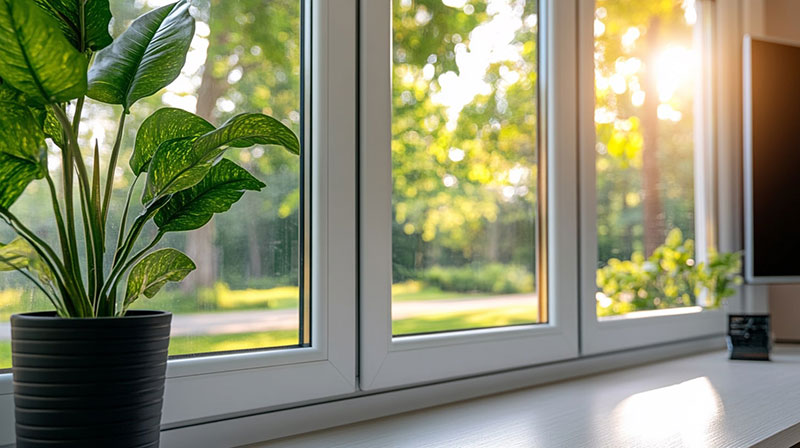
However, for homeowners prioritizing contemporary design, structural strength for oversized openings, or building in coastal areas, aluminum windows may justify their premium price through their distinctive appearance and exceptional durability.
"The window material you select becomes part of your home's character and performance for decades," emphasizes Eugene Siukayev. "That's why we encourage homeowners to consider not just the upfront cost or appearance, but how these windows will perform through our Canadian seasons year after year."
At Total Home Windows and Doors, we’ve found that about 75% of our residential customers ultimately select vinyl for its balance of performance and value, while approximately 25% choose aluminum for specific architectural or performance requirements.
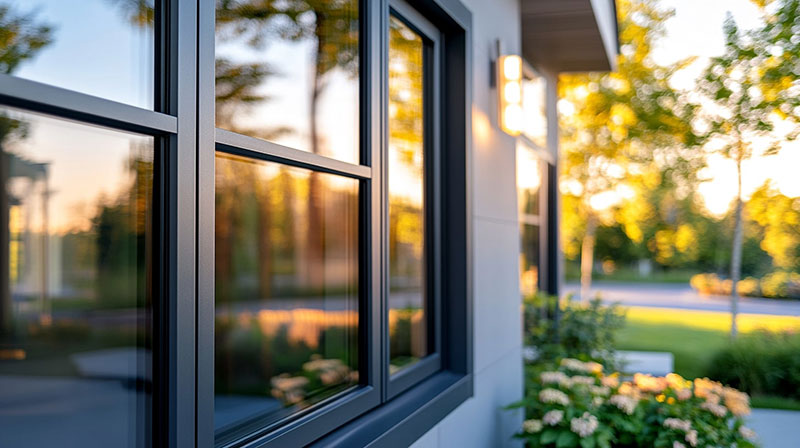
Whatever material you select, ensuring professional window installation is crucial to enjoying the full benefits of your investment. Even the highest quality windows will underperform if not correctly installed and sealed.
For personalized advice on which window material is right for your home and needs, we invite you to visit our showroom or contact our team of window experts for a consultation.
Frequently Asked Questions About Vinyl and Aluminum Windows
Does aluminum last longer than vinyl?
Yes, aluminum windows typically have a longer lifespan than vinyl windows. While quality vinyl windows can last 20-30 years, properly maintained aluminum windows often last 30-40+ years. Aluminum’s exceptional durability makes it particularly suitable for harsh environments like coastal areas with salty air.
Is vinyl window better than aluminum?
For most Canadian homes, vinyl windows offer better overall value due to superior energy efficiency and lower cost. However, aluminum windows excel in contemporary design applications and structural strength. The “better” choice depends on priorities, climate conditions, and architectural requirements.
What is the best material for window frames?
There’s no single “best” material for all situations. Vinyl frames offer excellent insulation and value, aluminum provides strength and modern aesthetics, fiberglass delivers durability with good insulation, and wood offers classic beauty. The best choice depends on your climate, budget, home style, and personal preferences.
Is thermally broken aluminum better than vinyl?
While thermally broken aluminum significantly improves energy performance over standard aluminum, vinyl typically provides better insulation in extremely cold conditions. However, thermally broken aluminum offers a compelling compromise for homeowners wanting aluminum’s sleek appearance without completely sacrificing energy efficiency.
What is the thermal break in aluminum windows?
A thermal break is a non-conductive material (usually polyamide or PVC) inserted between the interior and exterior aluminum frame sections. This barrier interrupts the thermal bridge, preventing heat transfer through the highly conductive aluminum and significantly improving the window’s insulation properties and condensation resistance.
Do vinyl windows have a thermal break?
Vinyl windows don’t require a separate thermal break because PVC is naturally non-conductive. The entire vinyl frame acts as an insulator, so vinyl windows generally offer better energy efficiency than standard aluminum windows without additional thermal break technology.
Are vinyl frames more cost-effective than aluminum?
Yes, vinyl frames typically cost 15-30% less than comparable aluminum windows while offering better energy efficiency. This makes vinyl replacement windows the more budget-friendly with better short-term ROI, especially when energy savings are factored into the total cost estimate.
How do aluminum and vinyl windows compare for maintenance?
Both aluminum and vinyl windows require less maintenance than wood, but vinyl has the edge. Vinyl needs only occasional cleaning with soap and water, while aluminum sometimes requires a special aluminum cleaner and may need more attention in coastal areas to prevent corrosion.
Can you get the same curb appeal with vinyl as with aluminum?
While aluminum windows offer a distinctive contemporary look with slimmer frames, modern vinyl windows have significantly improved their aesthetic appeal. Premium vinyl windows now come in a vast range of colors and finishes, including options that provide impressive curb appeal for traditional and transitional home styles.
Which is more environmentally friendly: vinyl or aluminum?
Aluminum has the environmental edge as it’s highly recyclable (up to 95% of the same material can be recycled), whereas vinyl’s environmental impact is more complex. However, vinyl’s superior energy efficiency provides ongoing ecological benefits through reduced energy consumption throughout the window’s lifetime.
Are double-hung windows available in both materials?
Yes, double-hung windows are widely available in both vinyl and aluminum. While vinyl is traditionally more common due to weight considerations, modern aluminum double-hung windows with quality hardware offer excellent operation and the benefit of aluminum’s sleek appearance.
How do I choose between vinyl and aluminum for replacement windows?
For most Canadian homeowners, vinyl is the choice if you prioritize energy efficiency, lower cost, and less maintenance. Select aluminum if you prefer contemporary aesthetics, need maximum strength, or have architectural requirements that benefit from aluminum’s slim profile and durability.

